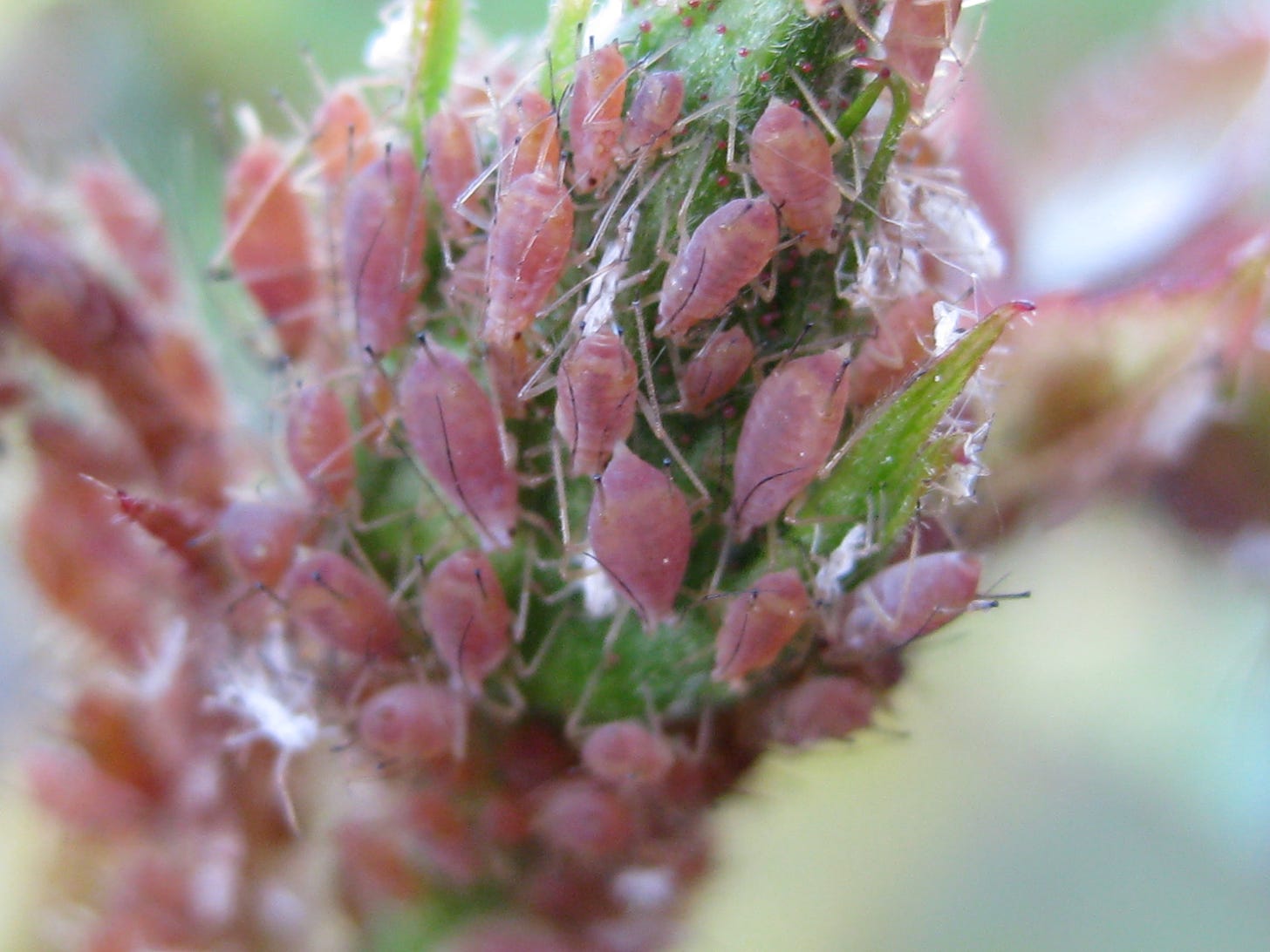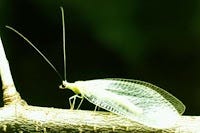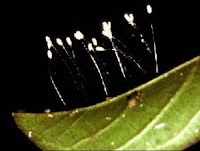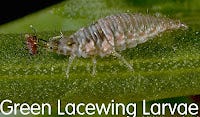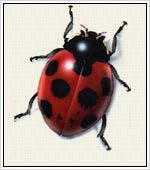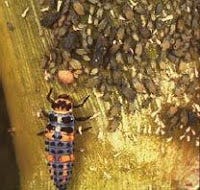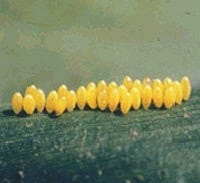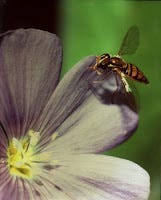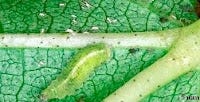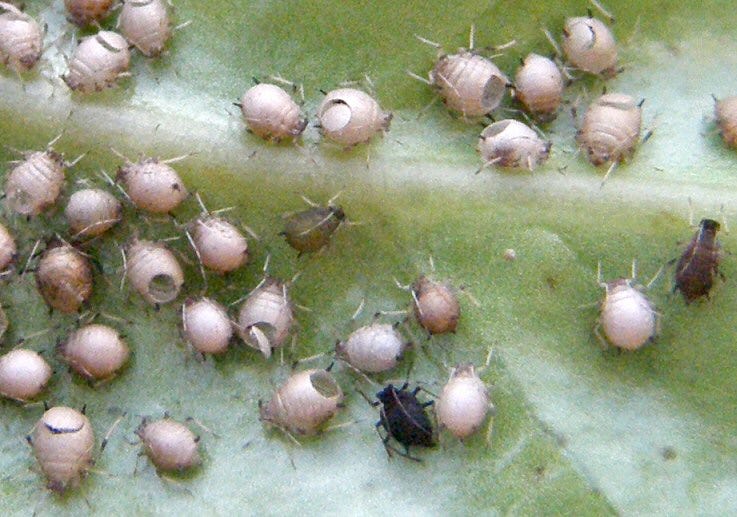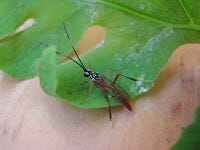All About Aphids...and Aphid Control
A deeper dive into Episode 137 of the Garden Basics with Farmer Fred Podcast
In Episode 137 of the Garden Basics podcast, we touched on aspects of controlling aphids in your garden.
First, a word or two about aphids. They suck. Literally. From UC IPM:
Aphids are small, soft-bodied insects with long slender mouthparts that they use to pierce stems, leaves, and other tender plant parts and suck out fluids. Almost every plant has one or more aphid species that occasionally feed on it. Aphids have many generations a year. Adult females give birth to live offspring—often as many as 12 per day—without mating. In some cases, aphids lay eggs on an alternative host, usually a perennial plant, for winter survival.
The good news: besides controlling aphid populations with a blast of water from your garden hose several times a week and regular garden cleanup, there are plenty of beneficial insects who want to help you control aphids. These beneficial predatory insects do not live on aphid steaks alone. They need other natural sources of food and shelter for their entire life cycle before they call your backyard a permanent home. And that’s the whole idea: building the “good bug hotel” in your yard. What are some of these beneficial insects and the"Welcome Mat" plants that they need to raise a family?
LACEWINGS
LACEWINGS(Chrysopa spp.)
Beautiful, little (3/4”) green or brown insects with large lacy wings.
Individual white eggs are found laid on the ends of inch-long stiff threads.
It is the larvae (which look like little alligators) that destroy most of the pests. They are sometimes called aphid lions for their habit of dining on aphids. On spring and summer evenings, lacewings can sometimes be seen clinging to porch lights, screens or windows.
Plants that attract lacewings:
•Achillea filipendulina Fern-leaf yarrow
•Anethum graveolens Dill
•Angelica gigas Angelica
•Anthemis tinctoria Golden marguerite
•Atriplex canescens Four-wing saltbush
•Callirhoe involucrata Purple poppy mallow
•Carum carvi Caraway
•Coriandrum sativum Coriander
•Cosmos bipinnatus Cosmos white sensation
•Daucus carota Queen Anne’s lace
•Foeniculum vulgare Fennel
•Helianthus maximilianii Prairie sunflower
•Tanacetum vulgare Tansy
•Taraxacum officinale Dandelion
LADYBUGS
LADYBUGS
Easily recognized when they are adults by most gardeners. However, the young larvae, black with orange markings, eat more pests than the adults, and they can’t fly. Yellowish eggs are laid in clusters usually on the undersides of leaves.
Plants that attract ladybugs:
•Achillea filipendulina Fern-leaf yarrow
•Achillea millefolium Common yarrow
•Ajuga reptans Carpet bugleweed
•Alyssum saxatilis Basket of Gold
•Anethum graveolens Dill
•Anthemis tinctoria Golden marguerite
•Asclepias tuberosa Butterfly weed
•Atriplex canescens Four-wing saltbush
•Coriandrum sativum Coriander
•Daucus carota Queen Anne’s lace
•Eriogonum fasciculatum CA Buckwheat
•Foeniculum vulgare Fennel
•Helianthus maximilianii Prairie sunflower
•Penstemon strictus Rocky Mt. penstemon
•Potentilla recta ‘warrenii’ Sulfur cinquefoil
•Potentilla villosa Alpine cinquefoil
•Tagetes tenuifolia Marigold “lemon gem”
•Tanacetum vulgare Tansy
•Taraxacum officinale Dandelion
•Veronica spicata Spike speedwell
•Vicia villosa Hairy vetch
HOVERFLIES
Also known as syrphid fly, predatory aphid fly or flower fly. Adults look like little bees that hover over and dart quickly away. They don’t sting! They lay eggs (white, oval, laid singly or in groups on leaves) which hatch into green, yellow, brown, orange, or white half-inch maggots that look like caterpillars.
They raise up on their hind legs to catch and feed on aphids, mealybugs and others.
Plants that attract hoverflies:
•Achillea filipendulina Fern-leaf yarrow
•Achillea millefolium Common yarrow
•Ajuga reptans Carpet bugleweed
•Allium tanguticum Lavender globe lily
•Alyssum saxatilis Basket of Gold
•Anethum graveolens Dill
•Anthemis tinctoria Golden marguerite
•Aster alpinus Dwarf alpine aster
•Astrantia major Masterwort
•Atriplex canescens Four-wing saltbush
•Callirhoe involucrata Purple poppy mallow
•Carum carvi Caraway
•Chrysanthemum parthenium Feverfew
•Coriandrum sativum Coriander
•Cosmos bipinnatus Cosmos white sensation
•Daucus carota Queen Anne’s lace
•Eriogonum fasciculatum CA Buckwheat
•Foeniculum vulgare Fennel
•Lavandula angustifolia English lavender
•Limnanthes douglasii Poached egg plant
•Limonium latifolium Statice
•Linaria vulgaris Butter and eggs
•Lobelia erinus Edging lobelia
•Lobularia maritima Sweet alyssum white
•Melissa officinalis Lemon balm
•Mentha pulegium Pennyroyal
•Mentha spicata Spearmint
•Monarda fistulosa Wild bergamot
•Penstemon strictus Rocky Mt. penstemon
•Petroselinum crispum Parsley
•Potentilla recta ‘warrenii’ Sulfur cinquefoil
•Potentilla villosa Alpine cinquefoil
•Rudbeckia fulgida Gloriosa daisy
•Sedum kamtschaticum Orange stonecrop
•Sedum spurium Stonecrops
•Solidago virgaurea Peter Pan goldenrod
•Stachys officinalis Wood betony
•Tagetes tenuifolia Marigold “lemon gem”
•Thymus serpylum coccineus Crimson thyme
•Veronica spicata Spike speedwell
•Zinnia elegans Zinnia "liliput"
PARASITIC MINI-WASPS
Includes Braconid wasps, Ichneumonid wasps, Trichogramma wasps. These are parasites of a variety of insects, including aphids. They do not sting! The stingers have been adapted to allow the females to lay their eggs in the bodies of insect pests. The eggs then hatch, and the young feed on the pests from the inside, killing them. After they have killed the pests, they leave hollow “mummies.”
Plants that attract parasitic mini-wasps:
•Achillea filipendulina Fern-leaf yarrow
•Achillea millefolium Common yarrow
•Allium tanguticum Lavender globe lily
•Anethum graveolens Dill
•Anthemis tinctoria Golden marguerite
•Astrantia major Masterwort
•Callirhoe involucrata Purple poppy mallow
•Carum carvi Caraway
•Coriandrum sativum Coriander
•Cosmos bipinnatus Cosmos white sensation
•Daucus carota Queen Anne’s lace
•Foeniculum vulgare Fennel
•Limonium latifolium Statice
•Linaria vulgaris Butter and eggs
•Lobelia erinus Edging lobelia
•Lobularia maritima Sweet alyssum - white
•Melissa officinalis Lemon balm
•Mentha pulegium Pennyroyal
•Petroselinum crispum Parsley
•Potentilla recta ‘warrenii’ Sulfur cinquefoil
•Potentilla villosa Alpine cinquefoil
•Sedum kamtschaticum Orange stonecrop
•Sweet alyssum - white
•Tagetes tenuifolia Marigold - lemon gem
•Tanacetum vulgare Tansy
•Thymus serpylum coccineus Crimson thyme
•Zinnia elegans Zinnia - 'liliput'
Thanks for Subscribing and Spreading the Word About the Garden Basics with Farmer Fred newsletter, I appreciate your support.
And thank you for listening to the Garden Basics with Farmer Fred podcast! It’s available wherever you get your podcasts. Please share it with your garden friends.
As an Amazon Associate, I earn from qualifying purchases from possible links mentioned here (sticky yellow traps for aphid monitoring/control).



